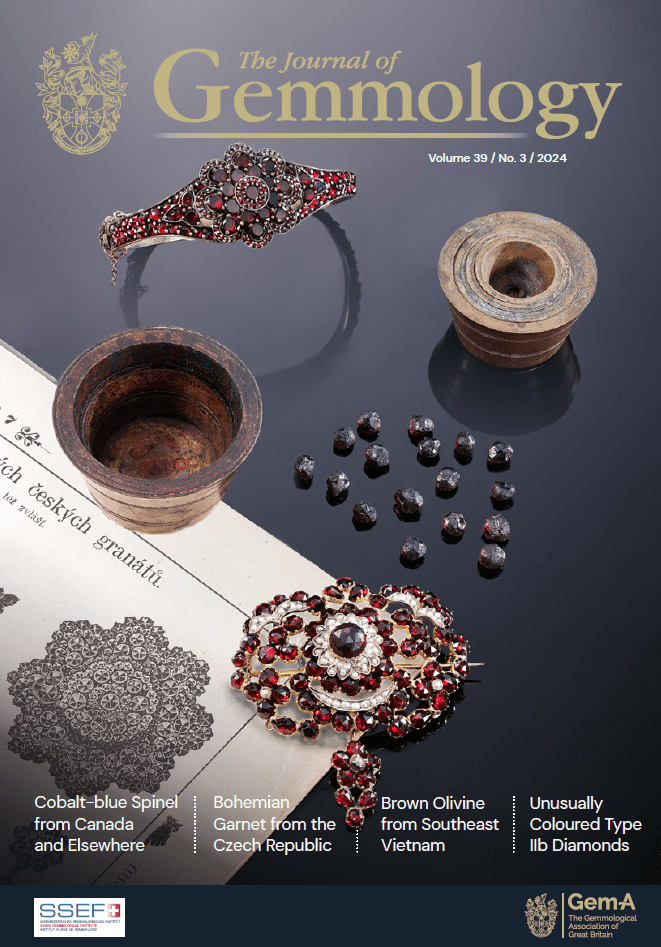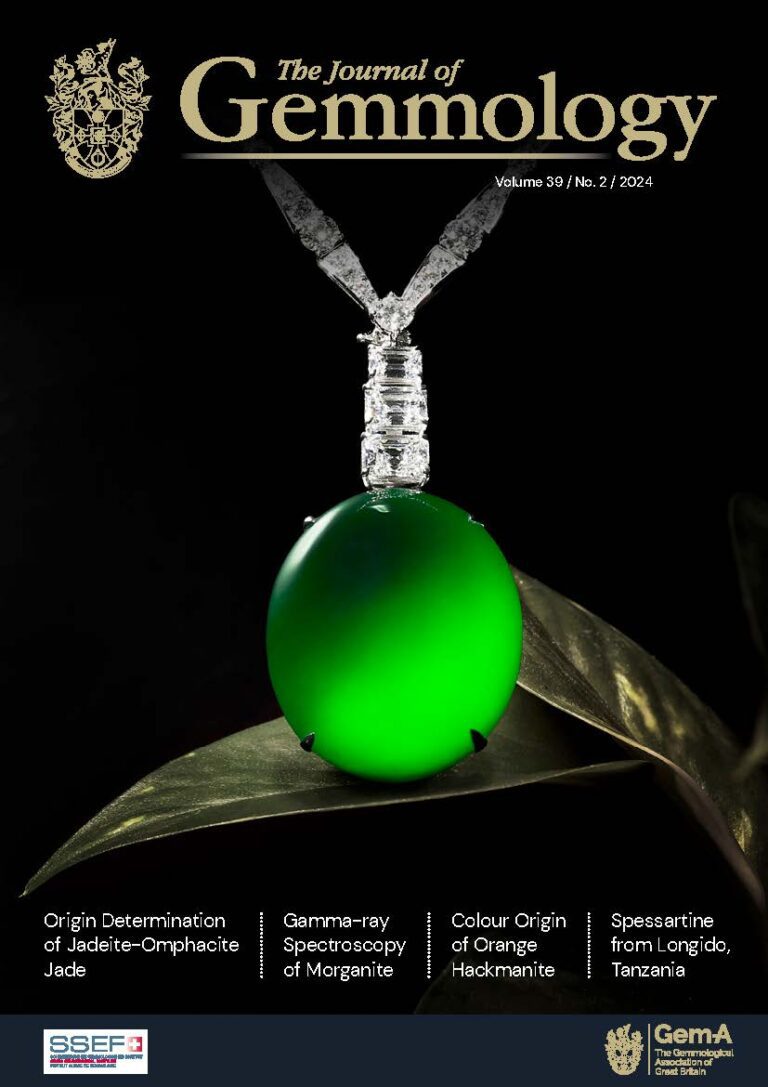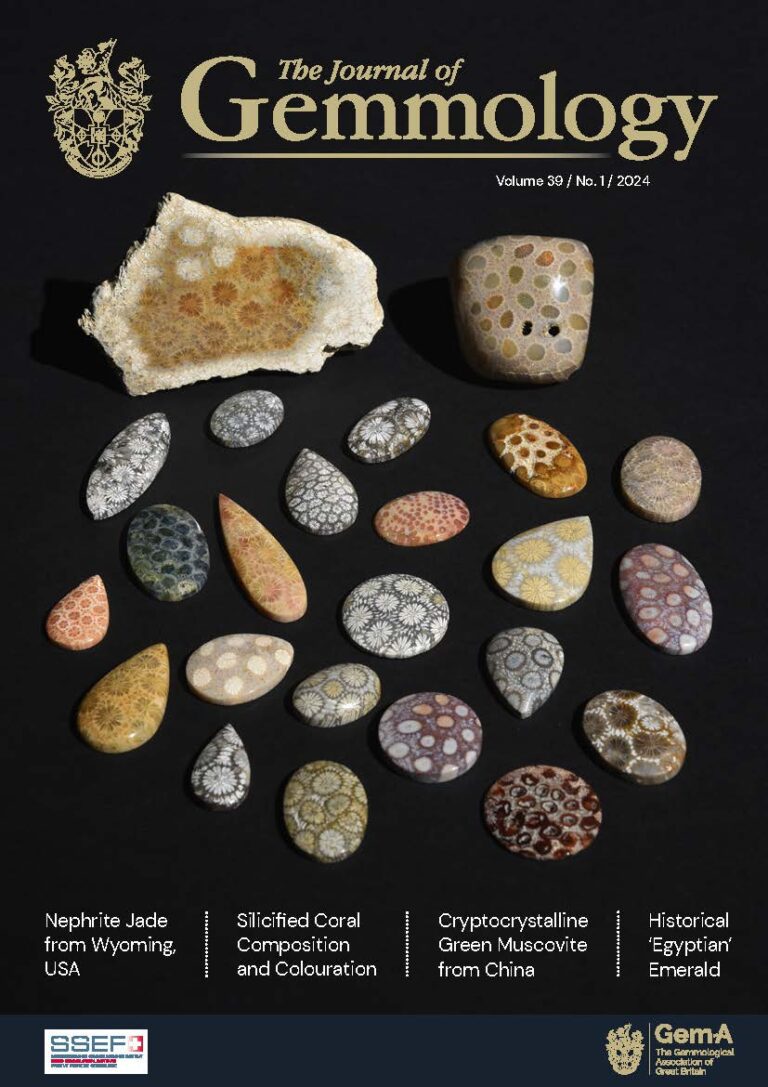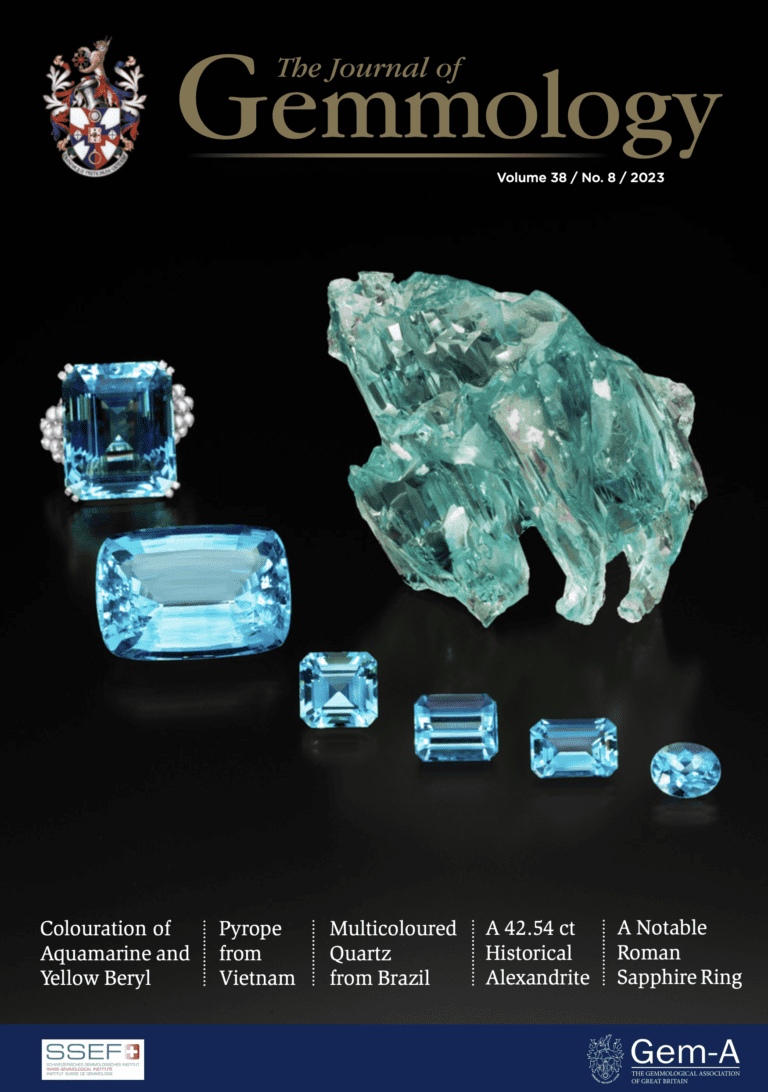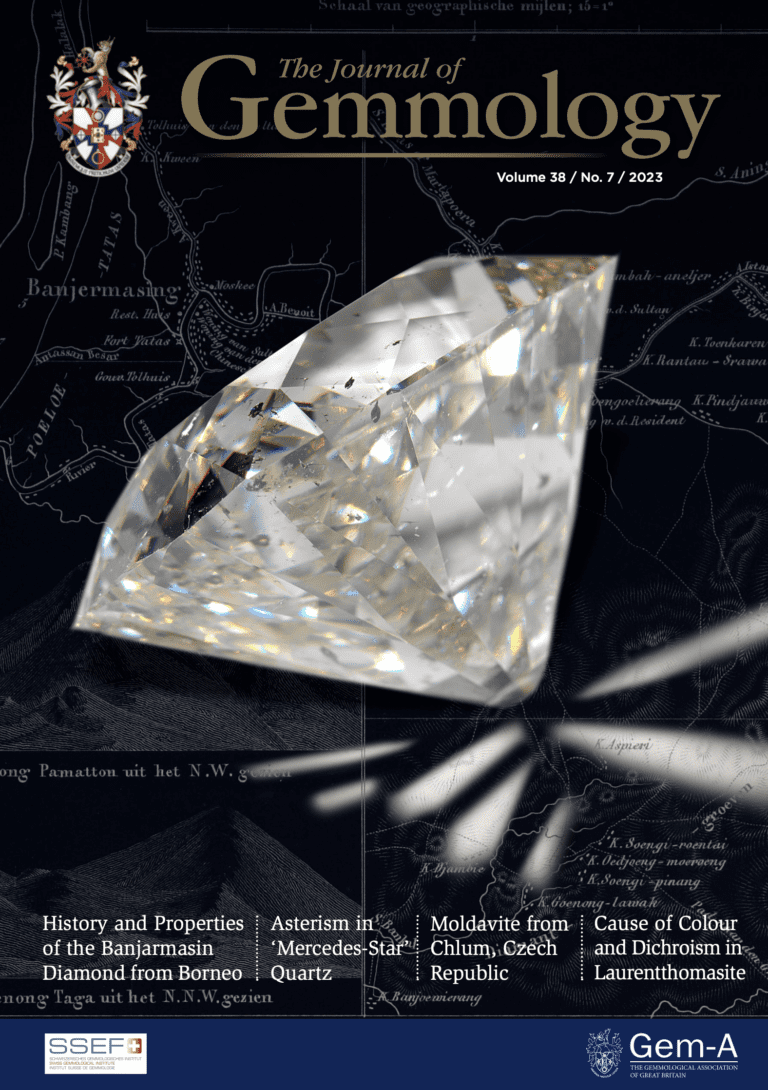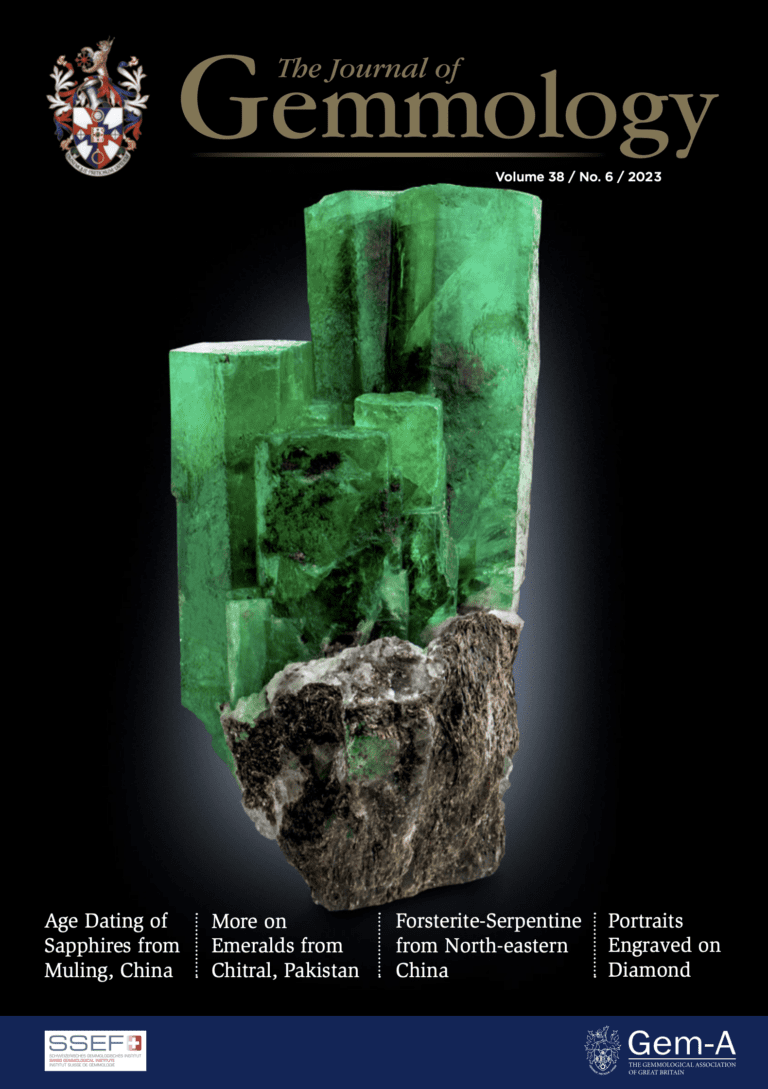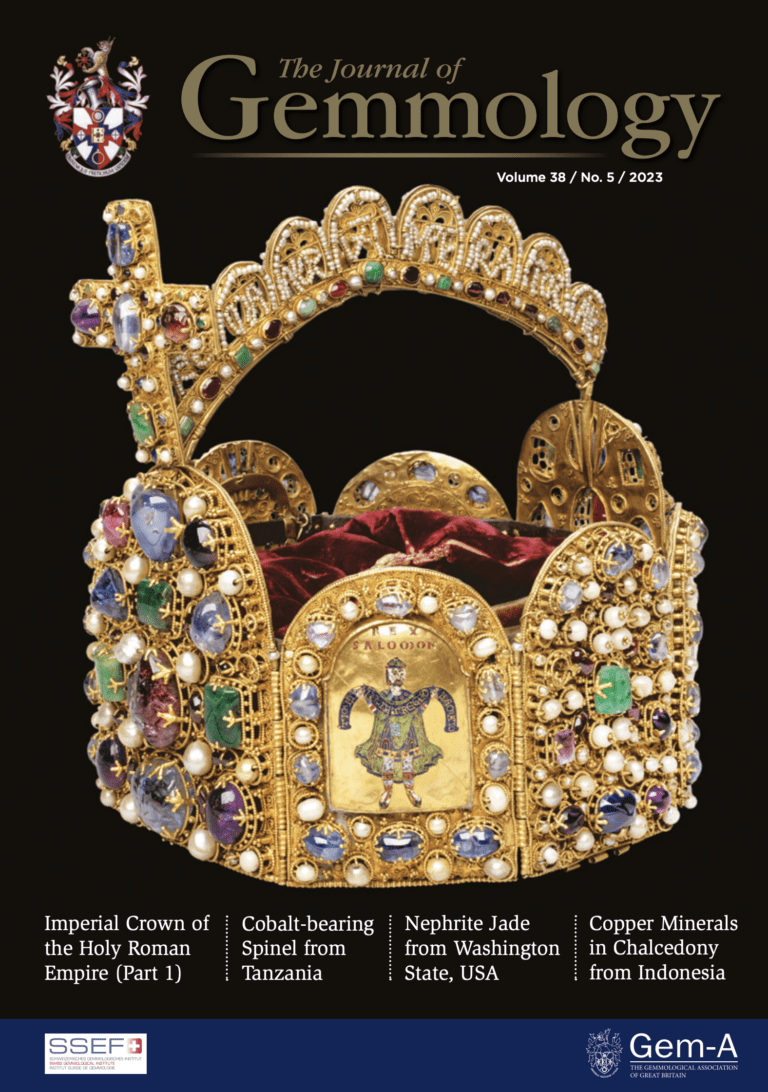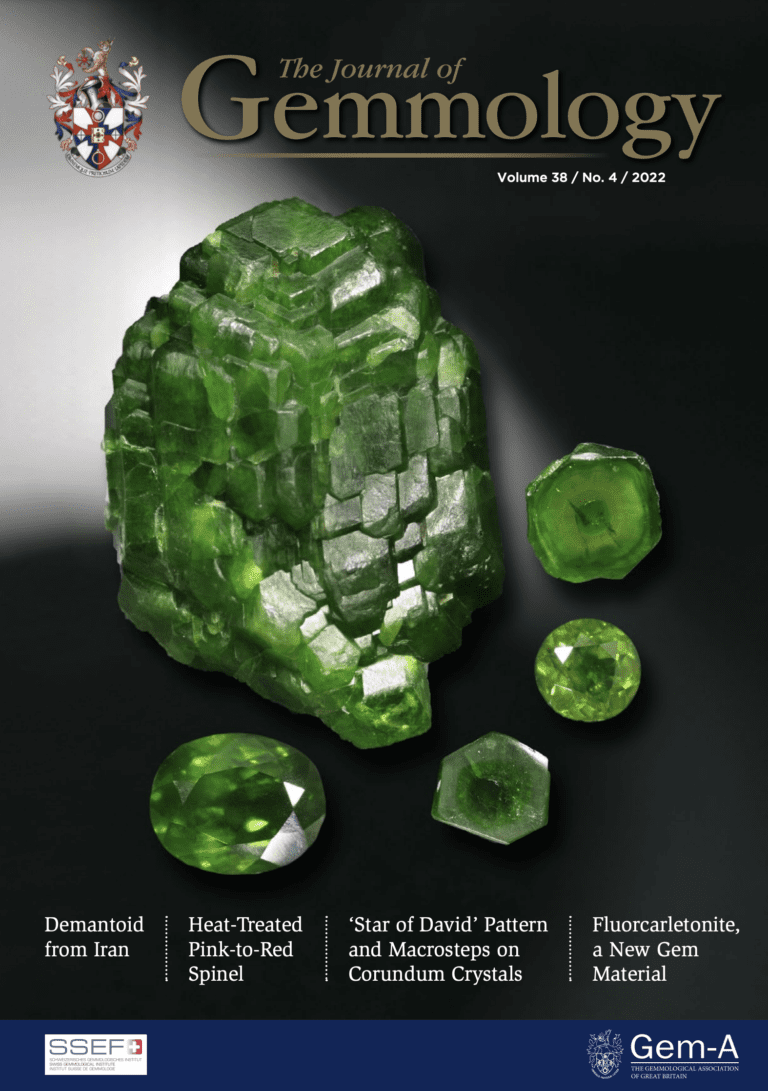The Journal of Gemmology
THE JOURNAL
Latest issues
Journal Information
ISSN: 1355-4565 (Print)
ISSN: 2632-1718 (Online)
View and download sample articles from The Journal.
View and download Publication Ethics and Malpractice Statement
Abstracting and Indexing
The Journal is indexed by the following abstracting and indexing services:
- Clarivate Analytics’ (formerly Thomson Reuters/ISI) Science Citation Index Expanded (SCIE, in the Web of Science), and Current Contents—Physical Chemical and Earth Sciences (impact factor =1.1 according to the 2023 Journal Citation Reports released in July 2024)
- Elsevier’s Scopus
- Australian Research Council’s Excellence in Research for Australia (ERA) Journal List
- EBSCO Discovery Service and TOC Premier
- EBSCO’s Academic Search Ultimate
- ProQuest (Cambridge Scientific Abstracts)
- GeoRef
- CrossRef
- Chemical Abstracts (CA Plus)
- Mineralogical Abstracts
- Index Copernicus ICI Journals Master List
- Gale Academic OneFile
- British Library Document Supply Service
- Copyright Clearance Center’s RightFind application
- China National Knowledge Infrastructure (CNKI Scholar)
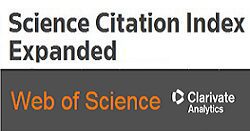

Original Research
The Journal of Gemmology contains original research articles on all aspects of gemmology, including natural stones and their treatments, synthetics and simulated gemstones. In addition, sections such as Gem Notes, What’s New, Conferences, Learning Opportunities, New Media and Literature of Interest inform readers about new instruments, publications, articles and educational events.
Submissions
We welcome original articles shedding new light on subjects of gemmological interest. We also appreciate contributions for the various sections of the publication. If you would like to submit material for consideration, please refer to the notes on the preparation of manuscripts below, or contact the Editor-in-Chief.
Articles:
Peer-reviewed technical articles describe previously unpublished research shedding new light on subjects of gemmological interest. Articles are not normally accepted which have already been published elsewhere in English (including on the Internet), and an article is accepted only on the understanding that:
- Full information as to any previous publication (including online, whether in English or another language) has been given;
- It is not under consideration for publication elsewhere;
- It will not be published elsewhere for at least three months without the consent of the Editor-in-Chief, and a reference to the original publication in The Journal of Gemmology must be provided.
GEMMOLOGICAL BRIEFS | 1,000–3,000 words and 4-8 figures |
FEATURE ARTICLES | 3,000–7,000 words and up to 25 figures |
REVIEW ARTICLES | 6,000–8,000 words and up to 30 figures |
Other sections:
| What’s New: Announcements of new instruments/technology, publications, databases, online resources, etc. | Up to 300 words and 1 image |
| Practical Gemmology: Tips on using commonly accessible gemmological instruments to solve gem identification challenges. | Up to 700 words and 4 images |
| Gem Notes: Short notes on items submitted to gem labs, analytical facilities, or research scientists worldwide.Please contact the Editor-in-Chief for assistance with having a new item characterised by a gem lab. | Up to 700 words and 4 figures |
| Conferences: Synopses of new gemmological findings presented at recent conferences. | Length varies depending on number of presentations; up to 3 figures total. |
| Letters: Reader correspondence pertaining to items published in previous issues; if appropriate, authors will be given an opportunity to reply | Up to 700 words and 1 image |
| New Media: Reviews of new books and DVDs (to be arranged by editor-in-chief) | 300-1000 words |
| Literature of Interest: Listing of new articles and conference proceedings of interest to gemmologists.Please supply full reference or article PDF | N/A |
| Learning Opportunities: Calendar of conferences, exhibits, field trips, and other educational events.Please supply event title, dates, location, and website. | N/A |
Author guidelines:
Articles should be submitted as a Word document by email to brendan@gem-a.com. The text should be formatted in the manner of recent issues of The Journal and in conformity with the information described below. Papers may be of various length, but long manuscripts of more than 10,000 words (unless capable of division into parts or of exceptional importance) are unlikely to be acceptable, whereas a short paper of 1,000 words may achieve early publication.
If English is not your first language, manuscripts should be checked by an expert translator before they are submitted to The Journal for consideration.
All articles and Gemmological Briefs are typically sent to at least three reviewers and are also subject to copy editing. Authors may indicate reviewers who they feel would be appropriate, and they can also suggest reviewers who they prefer to exclude from the review process due to possible conflicts of scientific interest. Reviewers need not be limited to The Journal’s Associate Editors. The decisions of the editors are final. Authors are given the opportunity to review the page proofs of their article and are held responsible for its content. Authors who publish in The Journal of Gemmology receive a total of 25 offprints of their article free of charge.
The following guidelines apply to all Articles and Gemmological Briefs:
Title Block: | The title should be brief and give a clear indication of the content of the paper. It should be followed by the full names of the authors and by their postal and email addresses. |
Abstract: | A short abstract of 100-200 words is required. |
Headings: | All headings should be formatted in all-caps, with first-level headings in italic font and any further subheadings in bold font. Most articles should contain the following section headings: Abstract, Introduction, Materials and Methods, Results, Discussion, Conclusions, References and Figure Captions. A general outline for articles is available upon request. |
Figures: | High-resolution digital files (TIF or JPG format), at 300 dpi and sized to at least 10 x 15cm, should be submitted by email or via a file transfer website. After a paper has been accepted for publication, line art such as spectra, diagrams, maps etc. should, if possible, be supplied as vector files (EPS format). Alternate formats include AI and SVG. In addtion, photos should be supplied as original unannotated high-resolution files. All illustrations (maps, diagrams and photos) are numbered consecutively with Arabic numerals (Figure 1, Figure 2, etc.) and must be called-out consecutively in the text. Figure captions should be informative and written in complete sentences. For photomicrographs, give the field of view or magnification. All photos should have the photographer listed. |
Tables: | Must be in Word or Excel format, and include a brief title. They are called-out in the text and numbered consecutively with Roman numerals (Table IV, etc.). |
References: | |
Author information: | Give the name and location/affiliation for each author. Complete addresses are preferred, but may be limited to city/state/province/country. An email address should also be provided for the corresponding author. |
Acknowledgements: | Mention the persons (but not co-authors), businesses or organisations that helped with the research, supply samples, prepare the manuscript, etc. Sourcing of funding (grants etc.) should also be listed. |
Index & Bibliography
THE JOURNAL OF GEMMOLOGY INDEX
Use the cumulative index to search for anything published in the archive of The Journal of Gemmology. We aim to update this index annually.THE JOURNAL OF GEMMOLOGY BIBLIOGRAPHIES 1947-2023
These bibliographic lists compile all articles, Gem Notes, etc. on particular gem materials published in The Journal of Gemmology since its inception in 1947.Institutional Subscriptions
If you are part of a Library or an Institution, you can subscribe directly to receive Gem-A’s Journal of Gemmology and Gems&Jewellery magazine.
Costs are as follows:
With a UK/Europe address: £186
Elsewhere: £210
To apply, please complete the form below and return to membership@gem-a.com
Click here to download the Library and Institutional Subscriptions form
If you are not part of a Library or an Institution but you would like to receive both Gem-A publications along with several additional benefits, you can apply to become an Associate or Corporate Member of Gem-A, take a look here: https://gem-a.com/membership
Media Pack
To learn more about advertising with Gem-A, download the media pack.
Sample Articles
The Journal of Gemmology is a peer reviewed, scientific journal, publishing cutting-edge research on a variety of topics that are important to a broad international audience. Take a look at a sample of feature articles below.
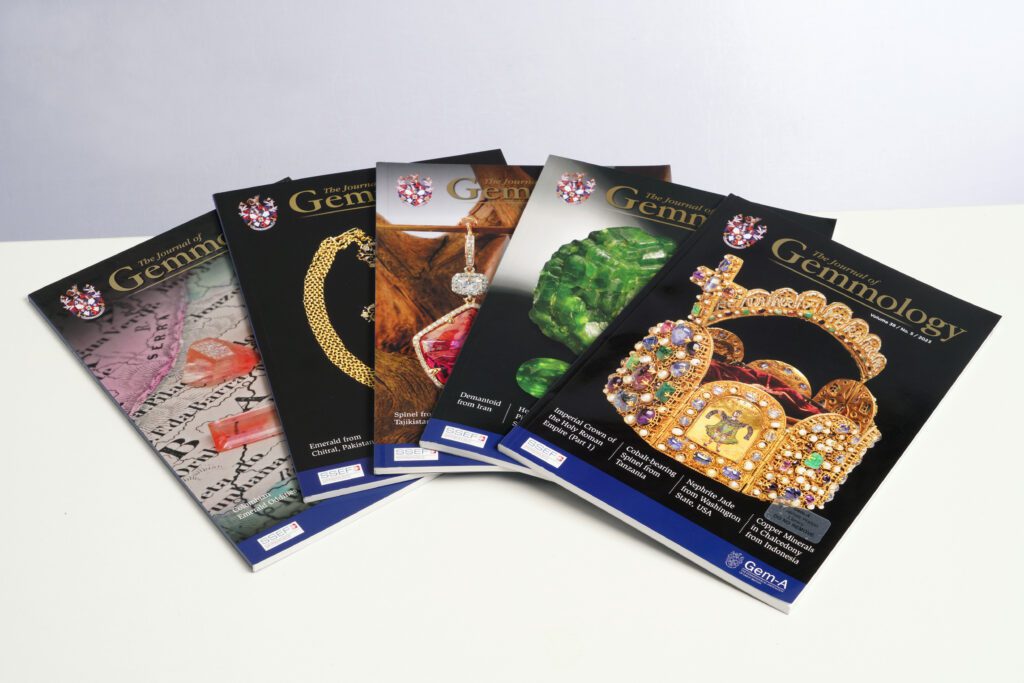

The Journal Archive
The Journal of Gemmology archive is now available for everyone to view online. The archive stretches all the way back to 1947 when the first issue of The Journal was published. Current Gem-A Members and Direct Subscribers receive free access to all available volumes of the publication. Simply log in using your membership number and password.
Data Depository
The Journal of Gemmology’s Data Depository includes freely downloadable reference materials, such as additional data, photos and other media supplied by authors to accompany articles published in The Journal.
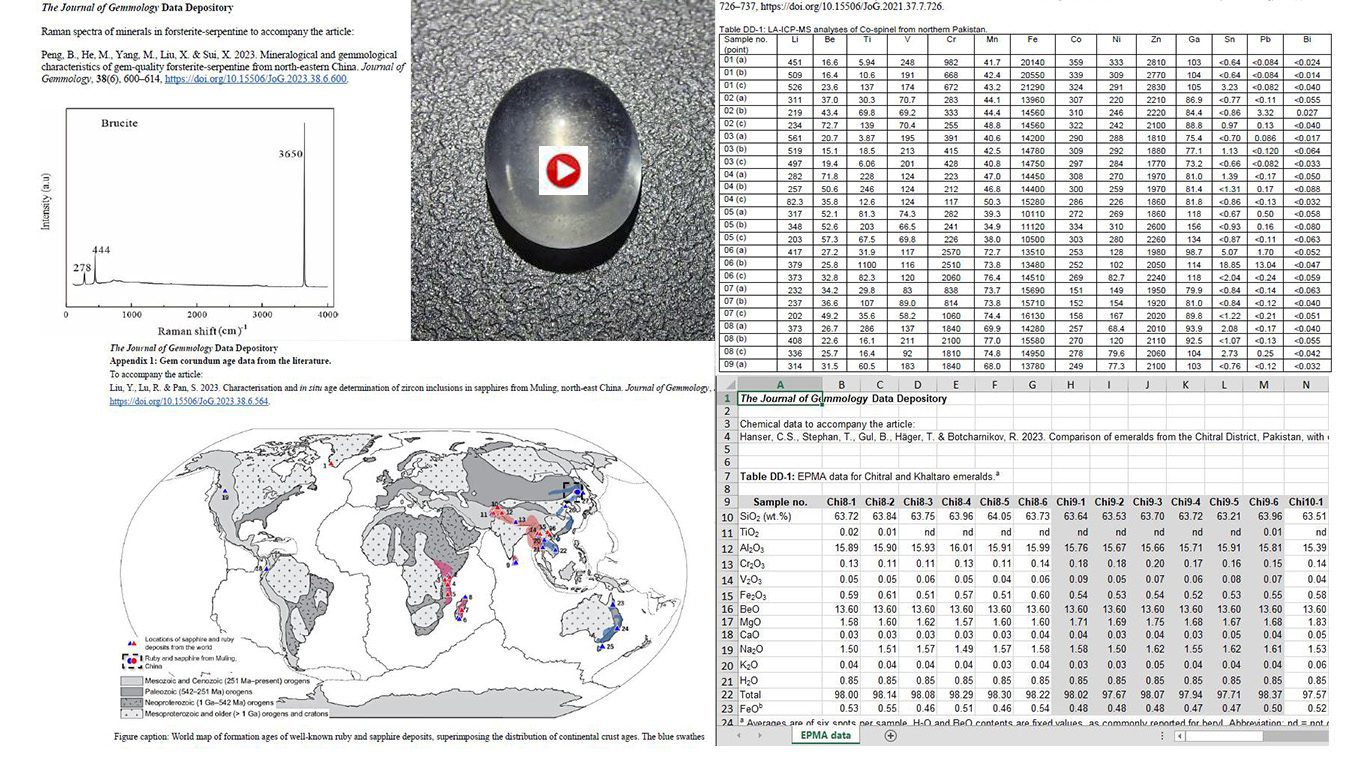

JOIN US TODAY
Choose your membership
To receive The Journal in print and online, and also enjoy online access to the most recent two years of back issues, please become a Gem-A Member, which includes all Membership benefits including an online subscription to Gem-A’s trade magazine Gems&Jewellery.
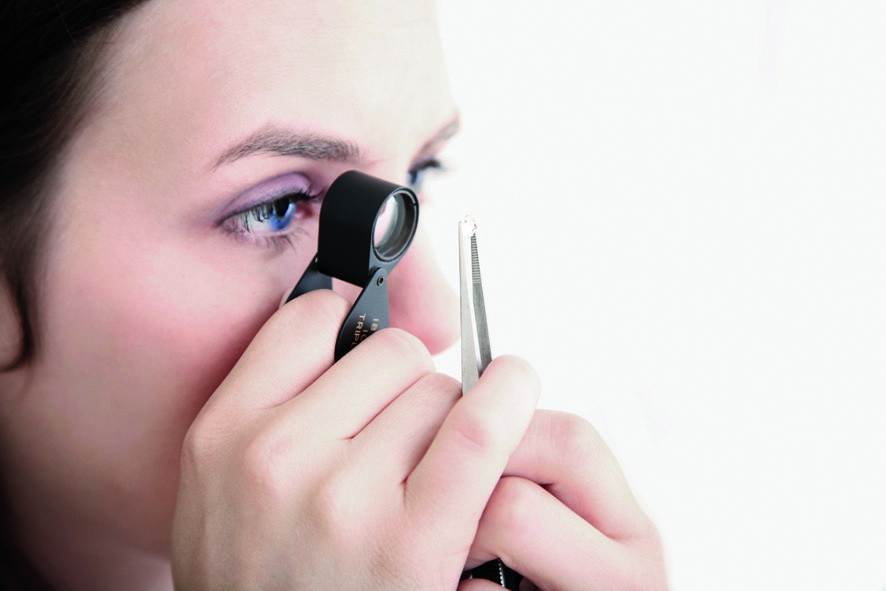

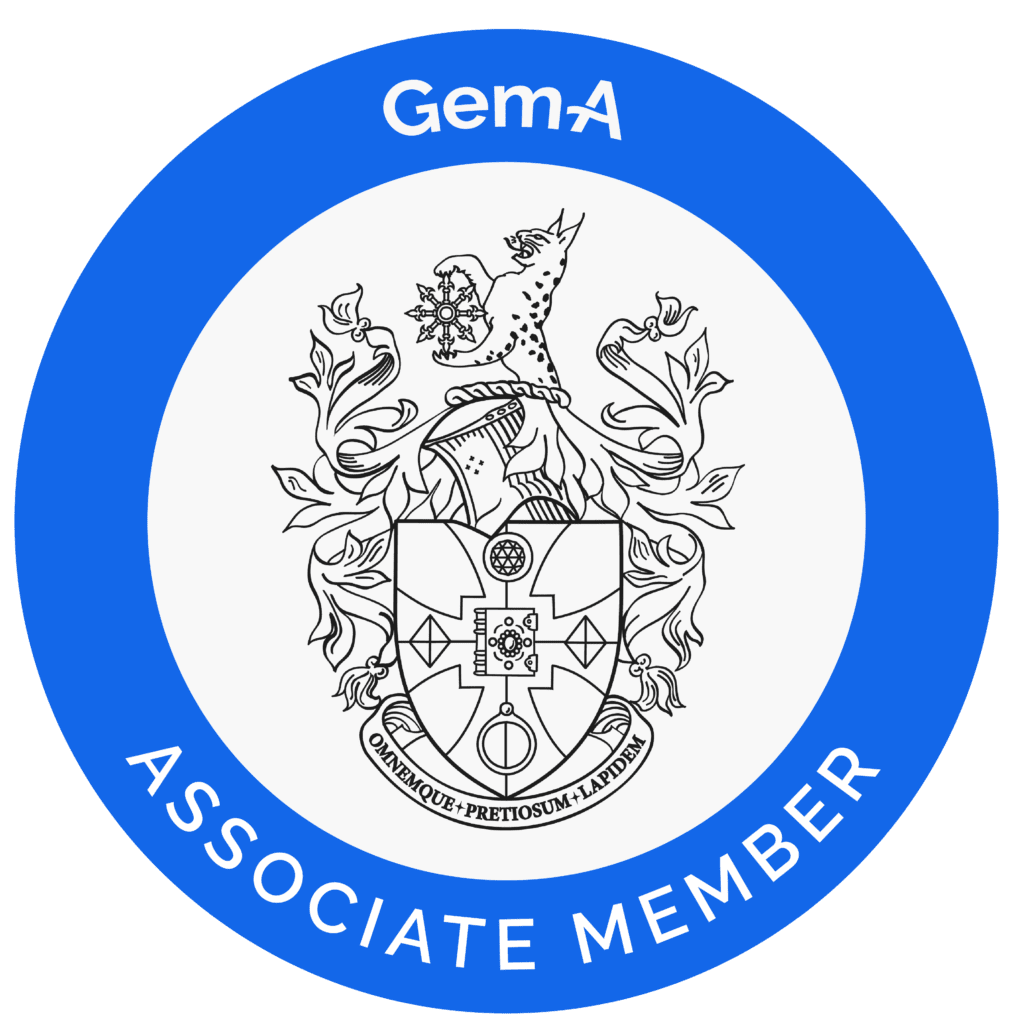

Associate Membership
FOR INDIVIDUALS
If you want to learn more about gemmology or diamonds and join a global network of enthusiasts, hobbyists and professionals, our associate membership is the best choice for you.
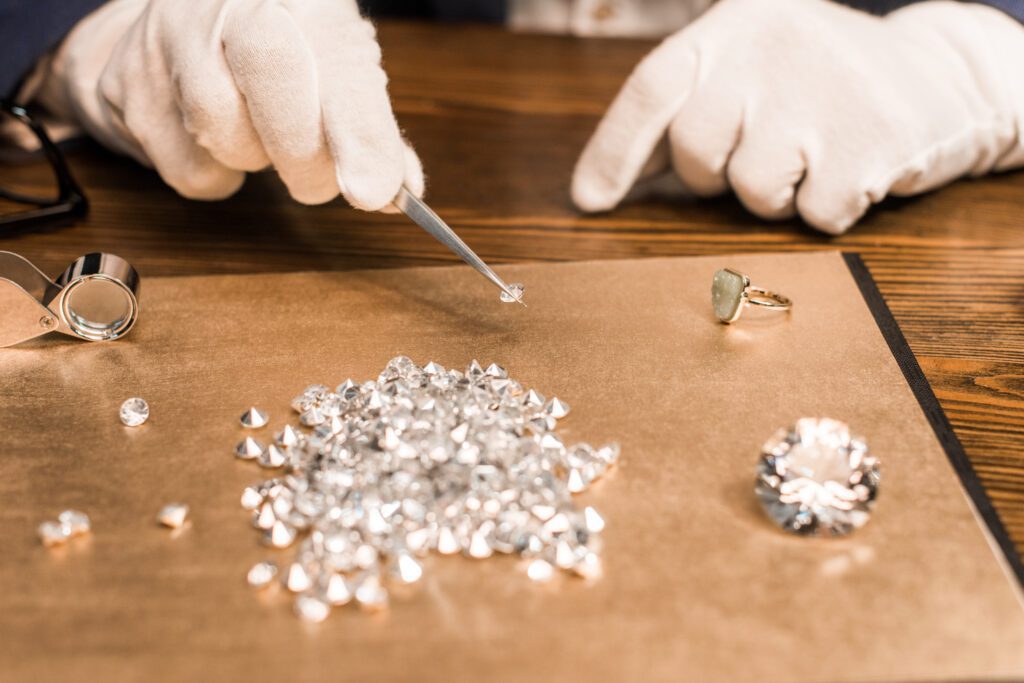

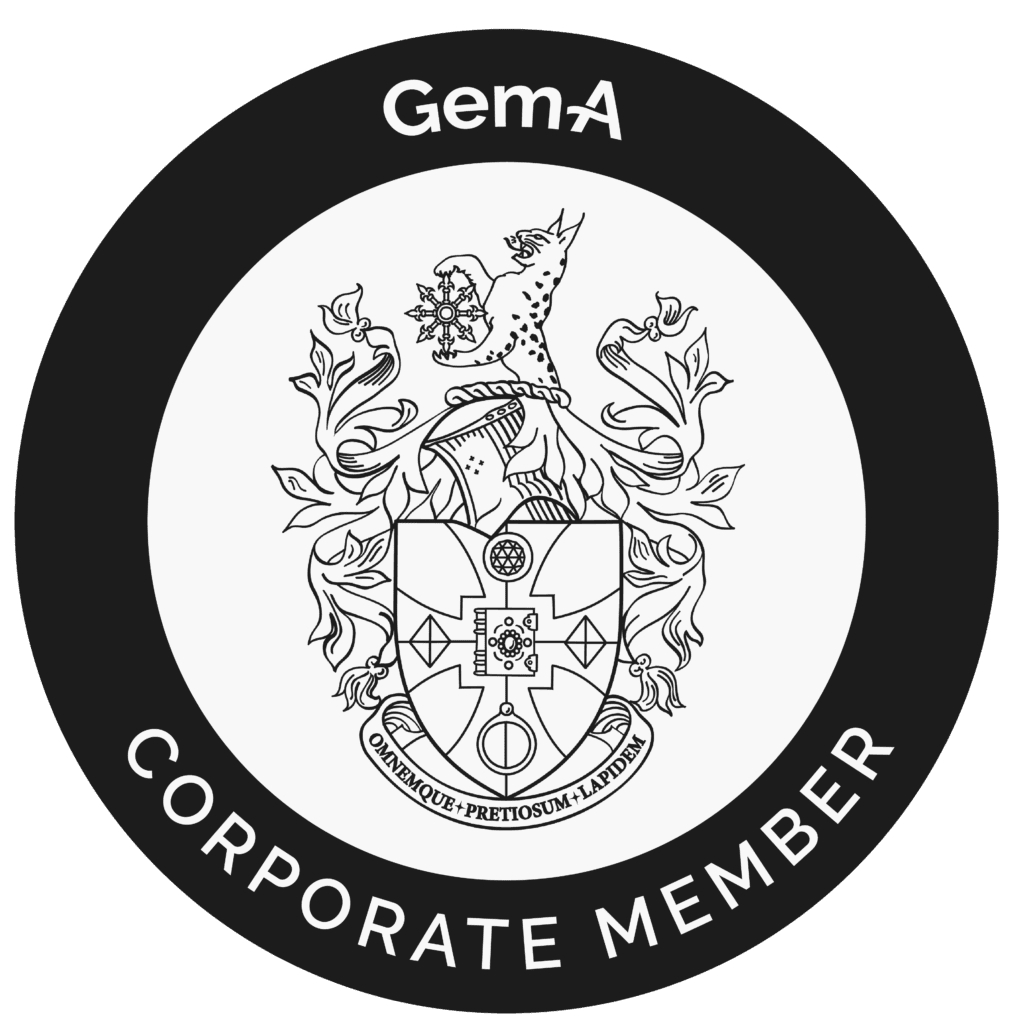

Corporate Membership
FOR ORGANISATIONS
If your business sells, auctions, manufactures or appraises gems or gem-set jewellery, our corporate membership inspires consumer confidence in your staff and business.
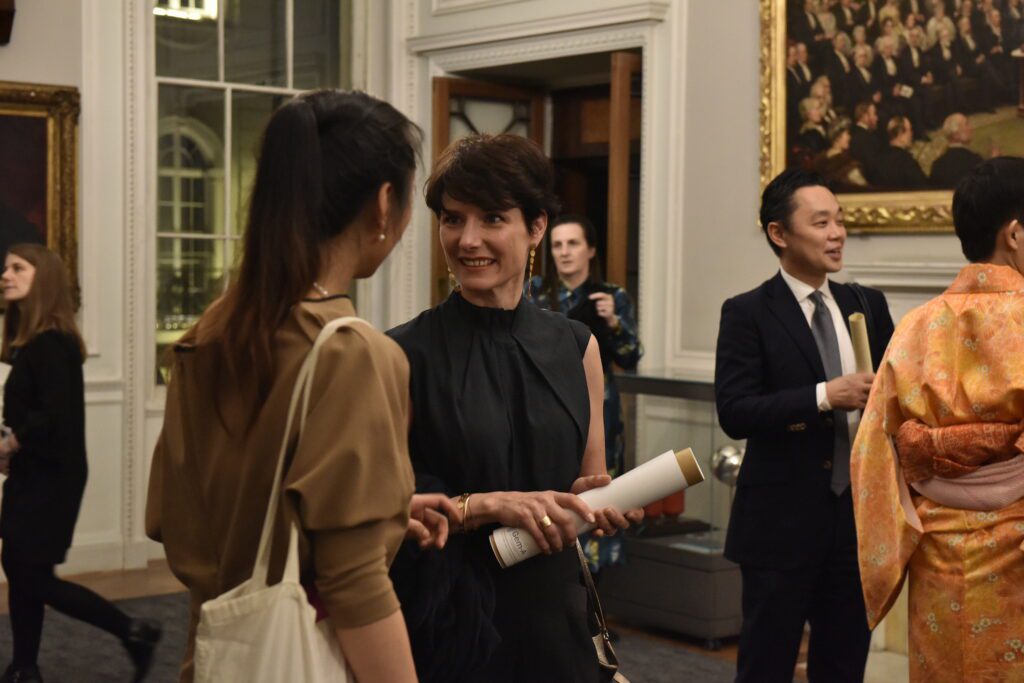

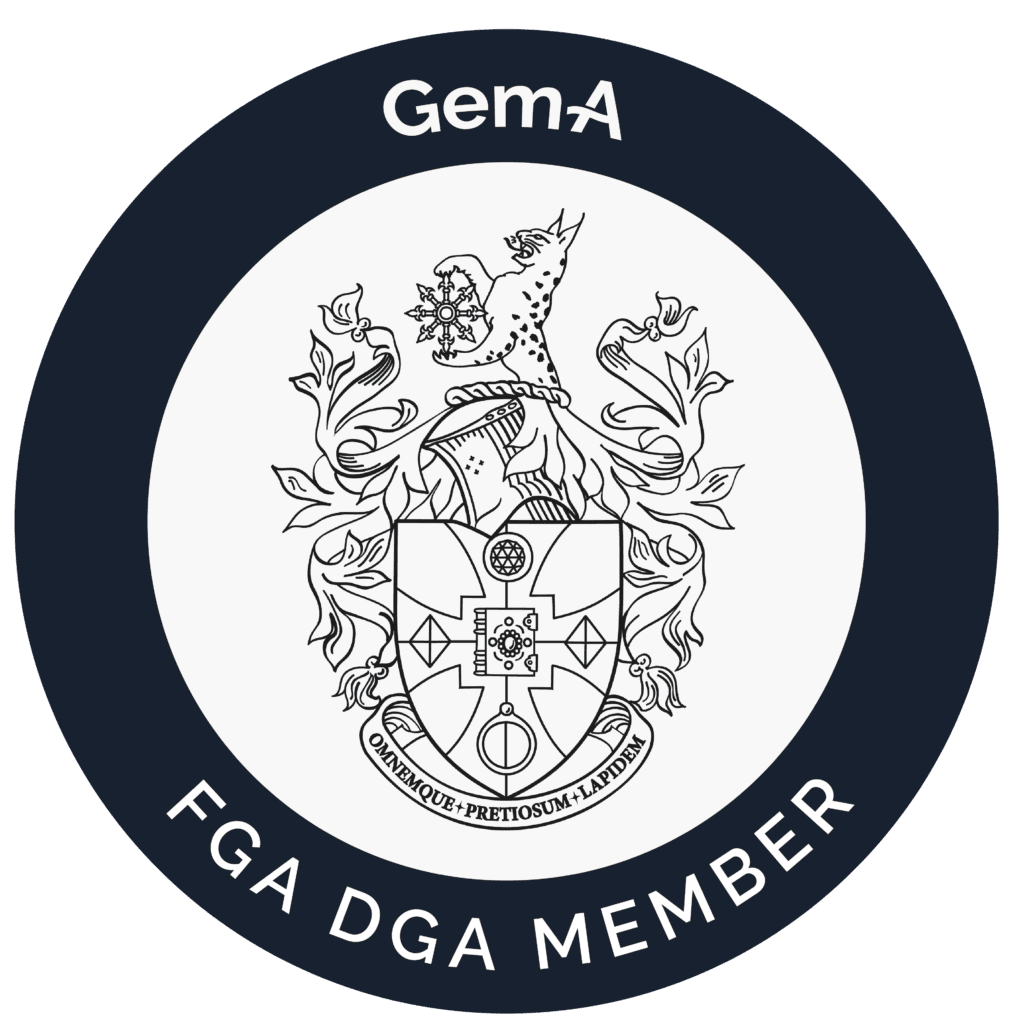

FGA DGA Membership
FOR DIPLOMA GRADUATES
If you’ve graduated from our Gemmology or Diamond Diploma, it’s time to enjoy the benefits of Gem-A Membership and be recognised for your expertise with exclusive post-nominals.
OUR TEAM
Meet the editors


Brendan Laurs
Brendan M. Laurs (MS, FGA, GG) is editor-in-chief of The Journal of Gemmology. He is a gemmologist and geologist specialising in the formation of coloured gemstone deposits, obtaining a BS degree in geology at UC Santa Barbara and an MS degree in geology from Oregon State University.
NAME | POSITION |
| Dr Ahmadjan Abduriyim | Tokyo Gem Science, Tokyo, Japan |
| Dr Raquel Alonso-Perez | Harvard Univeristy Mineralogical & Geological Museum, Cambridge, Massachusetts, USA |
| Edward Boehm | RareSource, Chattanooga, Tennesee, USA |
| Maggie Campbell Pedersen | London, UK |
| Prof. Alan T. Collins | King’s College London |
| Dr Alessandra Costanzo | National University of Ireland Galway |
| Dr John L. Emmett | Crystal Chemistry, Brush Prairie, Washington, USA |
| Prof. Emmanuel Fritsch | University of Nantes, France |
| Rui Galopim de Carvalho | Gem Education Consultant, Lisbon, Portugal |
| Al Gilbertson | Gemological Institute of America, Carlsbad, California, USA |
| Prof. Lee A. Groat | University of British Columbia, Vancouver, Canada |
| Dr Thomas Hainschwang | GGTL Laboratories, Balzers, Liechtenstein |
| Prof. Dr Henry A. Hänni | GemExpert, Basel, Switzerland |
| Dr Jeff W. Harris | University of Glasgow |
| Alan D. Hart | Gem-A, London, UK |
| Dr Ulrich Henn | German Gemmological Association, Idar-Oberstein, Germany |
| Dr Jaroslav Hyršl | Prague, Czech Republic |
| Brian Jackson | National Museums Scotland, Edinburgh |
| Dr Mary L. Johnson | Mary Johnson Consulting, San Diego, California, USA |
| Dr Stefanos Karampelas | Laboratoire Français de Gemmologie, Paris, France |
| Dr Lore Kiefert | Dr. Lore Kiefert Gemmology Consulting, Heidelberg, Germany |
| Dr Hiroshi Kitawaki | Central Gem Laboratory, Tokyo, Japan |
| Dr Michael S. Krzemnicki | Swiss Gemmological Institute SSEF, Basel, Switzerland |
| Shane F. McClure | Gemological Institute of America, Carlsbad, California, USA |
| Dr Jack M. Ogden | London, UK |
| Prof. Gérard Panczer | Claude Bernard University Lyon 1, France |
| Dr Federico Pezzotta | Mineralogical Collection Professionals, Milan, Italy |
| Dr Jeffrey E. Post | Smithsonian Institution, Washington DC, USA |
| Prof. George Rossman | California Institute of Technology, Pasadena, California, USA |
| Dr Karl Schmetzer | Petershausen, Germany |
| Dr Dietmar Schwarz | Zmpery Gemology Lab, Shanghai, China |
| Menahem Sevdermish | Gemewizard Ltd, Ramat Gan, Israel |
| Prof. Andy H. Shen | China University of Geosciences, Wuhan, China |
| Dr Guanghai Shi | China University of Geosciences, Beijing |
| Dr James E. Shigley | Gemological Institute of America, Carlsbad, California, USA |
| Christopher P. Smith | American Gemological Laboratories Inc., New York, USA |
| Elisabeth Strack | Gemmologisches Institut Hamburg, Germany |
| Tay Thye Sun | Far East Gemological Laboratory, Singapore |
| Dr Frederick ‘Lin’ Sutherland | Port Macquarie, New South Wales, Australia |
| Dr Pornsawat Wathanakul | Kasetsart University, Bangkok, Thailand |
| Dr Chris M. Welbourn | Reading, Berkshire, UK |
| Bear Williams | Stone Group Laboratories LLC, Jefferson City, Missouri, USA |
| Dr J. C. (Hanco) Zwaan | Naturalis Biodiversity Center, Leiden, Netherlands |
Frequently Asked Questions
Publication Ethics and Malpractice Statement
The Gemmological Association of Great Britain (Gem-A) publishes The Journal of Gemmology. The Journal of Gemmology (the Journal) adheres to the principles outlined by the Committee on Publication Ethics (http://publicationethics.org). Conformance to standards of ethical behaviour is therefore expected of authors, editors and reviewers.
Responsibilities of Authors
Reporting Standards
Authors should present an accurate account of the work performed as well as an objective discussion of its significance. Underlying data should be represented accurately in the paper. The results of research should be recorded and maintained in a form that allows analysis and review. Fraudulent or knowingly inaccurate statements constitute unethical behaviour and are unacceptable.
Originality and Plagiarism
Authors should ensure that their work is entirely original, and if the work and/or words of others have been used, this has been appropriately cited or quoted. Plagiarism in all its forms constitutes unethical scholarly behaviour and is unacceptable. Information obtained by private communication, correspondence or discussions with third parties should not be used without the consent of the correspondent source.
Applicable copyright laws and conventions should be followed. Copyright material (e.g. tables, figures or extensive quotations) should be reproduced only with appropriate permission and acknowledgement.
Multiple or Concurrent Publications
Authors should not in general publish articles describing essentially the same research to more than one journal. Submitting the same manuscript to more than one journal concurrently constitutes unethical publishing behaviour and is unacceptable. Publication in different languages in more than one journal is acceptable, provided that the primary reference is cited in the secondary publication.
Acknowledgement of Sources
Proper acknowledgement of the work of others used in a research project must always be given.
Authorship of the Paper
Authorship should be limited to those who have made a significant contribution to the conception, design, execution, or interpretation of the reported study. All those who have made significant contributions should be listed as co-authors. Where there are others who have participated in certain substantive aspects of the research project, they should be mentioned in the Acknowledgements section.
The corresponding author should ensure that all appropriate co-authors and no inappropriate co-authors are included on the paper and that all co-authors have seen and approved the final version of the paper and have agreed to its submission for publication.
Disclosure of Financial Support
All sources of financial support for the project should be disclosed.
Acknowledgements
All sources of support (financial and technical) and details thereof should be named in the Acknowledgements section. These include grants, honoraria, industrial and academic support.
Errors in Published Work
When an author discovers a significant error or inaccuracy in his/her own published work, it is the author’s obligation to promptly notify the editor or publisher and cooperate to retract or correct the contribution.
Responsibilities of Editors
Publication Decisions
The editor-in-chief of The Journal is responsible for deciding which of the articles submitted to The Journal should be published. The validation of the work in question and its importance to researchers and readers must always drive such decisions.
Fair Play
The editors should evaluate manuscripts exclusively on the basis of their academic merit without regard to race, gender, sexual orientation, religious belief, ethnic origin, citizenship, or political philosophy of the authors.
Confidentiality
The editors and the editorial staff should not disclose any information about a manuscript under consideration to anyone other than the corresponding author, reviewers, potential reviewers, and the publisher, as appropriate.
The Journal does not disclose reviewers’ identities. However, if reviewers wish to disclose their names, this is permitted.
Disclosure and Conflicts of Interest
The editors must not use unpublished materials for their own research without the express written consent of the author. If they feel unable to handle a submission in an unbiased way, the editors should excuse themselves from considering manuscripts in which they have conflicts of interest resulting from competitive, collaborative, or other relationships with any of the authors, companies, or institutions connected to the papers.
Corrections
When genuine errors in published work are pointed out by readers, authors, or editors, which do not render the work invalid, a correction (or erratum) will be published as soon as possible. The online version of the paper may be corrected with a note indicating an appropriate resolution to the problem.
Responsibilities of Reviewers
Members of the editorial board of The Journal (Associate Editors) are committed to ensuring ethics in publication and the high quality of articles.
Contribution to Editorial Decisions
All articles published in The Journal are subjected to double-blind peer review. Peer reviewers should be experts in the scientific topic addressed in the articles they review, and should be selected for their objectivity and scientific knowledge. Peer review assists the editor-in-chief in making editorial decisions and through anonymous communications with the authors may also assist the author in improving the contribution.
Promptness
Any selected referee who feels unqualified to review the research reported in a manuscript or knows that its prompt review will be impossible should notify the editor-in-chief and excuse himself from the review process.
Confidentiality
Any manuscripts received for review must be treated as confidential documents. They must not be shown to or discussed with others except as authorized by the editor-in-chief.
Standards of Objectivity
Reviews should be conducted objectively. Personal criticism of the author is inappropriate. Referees should express their views clearly with supporting arguments.
Acknowledgement of Sources
Reviewers should point out relevant published work that has not been cited by the authors. A reviewer should also call to the editor-in-chief’s attention any substantial similarity between the manuscript under consideration and any other published paper of which he/she has personal knowledge.
Disclosure and Conflicts of Interest
Privileged information or ideas obtained through peer review must not be used for personal advantage. Reviewers should not consider manuscripts in which they have conflicts of interest resulting from competitive, collaborative, or other relationships or connections with any of the authors, companies, or institutions connected to the papers.
We welcome original articles shedding new light on subjects of gemmological interest. We also appreciate contributions to the various sections of the publication. If you would like to submit material for consideration, please refer to the notes on the preparation of manuscripts by contacting the Editor-in-Chief.
Submission Guidelines for Articles
Peer-reviewed technical articles describe previously unpublished research shedding new light on subjects of gemmological interest. Articles are not normally accepted which have already been published elsewhere in English (including on the Internet), and an article is accepted only on the understanding that:
- Full information as to any previous publication (including online, whether in English or another language) has been given.
- It is not under consideration for publication elsewhere.
- It will not be published elsewhere for at least three months without the consent of the Editor-in-Chief, and a reference to the original publication in The Journal of Gemmology must be provided.
Article types include:
| Gemmological briefs | 1,000–3,000 words and 4-8 figures |
| Feature articles | 3,000–7,000 words and up to 25 figures |
| Review articles | 6,000–8,000 words and up to 30 figures |
Submission Guidelines for Other Sections
| What’s New
Announcements of new instruments/technology, publications, databases, online resources, etc. |
Up to 300 words and 1 image |
| Practical Gemmology
Tips on using commonly accessible gemmological instruments to solve gem identification challenges. |
Up to 700 words and 4 images |
| Gem Notes
Short notes on items submitted to gem labs, analytical facilities, or research scientists worldwide. Please contact the Editor-in-Chief for assistance with having a new item characterised by a gem lab. |
Up to 700 words and 4 figures |
| Conferences
Synopses of new gemmological findings presented at recent conferences. |
Length varies depending on number of presentations; up to 3 figures total. |
| Letters
Reader correspondence pertaining to items published in previous issues; if appropriate, authors will be given an opportunity to reply |
Up to 700 words and 1 image |
| New Media
Reviews of new books and DVDs (to be arranged by editor-in-chief) |
300-1000 words |
| Literature of Interest
Listing of new articles and conference proceedings of interest to gemmologists. Please supply full reference or article PDF |
N/A |
| Learning Opportunities
Calendar of conferences, exhibits, field trips, and other educational consequences. Please supply event title, dates, location, and website. |
N/A |
For all submissions, information about author guidelines, referencing guides and publishing agreements, please contact the Editor-in-Chief.
If you are part of a Library or an Institution, you can subscribe directly to receive Gem-A’s Journal of Gemmology and Gems&Jewellery magazine.
Costs are as follows:
With a UK/Europe address: £186
Elsewhere: £210
To apply, please complete the form below and return it to membership@gem-a.com
Download the form
If you are not part of a Library or an Institution but you would like to receive both Gem-A publications along with a number of additional benefits, you can apply to become an Associate or Corporate Member of Gem-A.
If you are missing any issue hardcopies from your Journal of Gemmology collection, you may be able to order back issues from our head office at Ely Place. To check availability and pricing, click the link below.
Use the cumulative index to search for anything published in the archive of The Journal of Gemmology. We aim to update this index annually.
- Download the Index (1947-2022) here
The Journal of Gemmology bibliographic lists compile all articles, Gem Notes, etc. on particular gem materials published in The Journal of Gemmology since its inception in 1947. Additional gem material bibliographies will be added as they are completed, and we aim to update these lists annually.
- Asterism/Chatoyancy
- Biogenics
- Chrysoberyl
- Colour change
- Corundum
- Diamond
- Emerald
- Feldspars
- Garnet
- Historical Gems and Jewels
- Jades
- Opal
- Pearl
- Quartz
- Spinel
- Tourmaline
